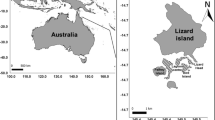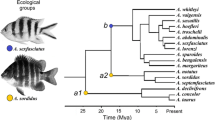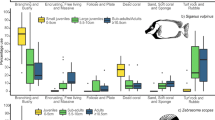Abstract
We surveyed fish distribution in three lagoons and adjacent forereefs in the British Virgin Islands recording about 28,000 fish from 40 families and 118 species. Canonical correspondence indicated that rock, sand, fleshy algae, gorgonians, mangroves and live hard coral were the most important habitat types influencing fish assemblage composition. About 47% of fishes occurring at more than 10 stations displayed evidence of ontogenetic partitioning between reefs and lagoons but post-settlement ontogenetic life history strategies were quite varied depending on the species. For example Chaetodon striatus juveniles occurred exclusively in lagoons and all sexually mature adults were found on reefs. Some differences were less pronounced as seen in Halichoeres bivittatus where individuals of all sizes occurred on reefs and lagoons, but when analysed it was found that reefs had larger individuals than lagoons. Some species, such as Acanthurus bahianus, were primarily reef species whose juveniles also used lagoon habitats while others, such as Gerres cinereus, were generally lagoon species whose adults occasionally moved onto reefs. Even with all this variation in life-history strategies, all the species that exhibited bay-reef partitioning used the lagoons as juveniles then moved onto reefs as adults and not vice versa, supporting the hypothesis that bays are important nursery areas for reef-dwelling fishes. These results show that a detailed review of the natural life-history strategies and habitat requirements are required before making further generalisations about the role of near-shore habitat types as nurseries for reef fishes. This is especially important given the rapid changes in tropical near-shore habitats around the world.
Similar content being viewed by others
References
Adams AJ, Ebersole JP (2002) Use of back-reef and lagoon habitats by coral reef fishes. Mar Ecol Progr Ser 228:213–226
Al JS, Al JM, Al BA, Baldwin RM, Wilson SC, West F, Matthews AD (1999) Human impacts on coral reefs in the Sultanate of Oman. Estuarine Coastal Shelf Sci 49:65–74
Appeldoorn RS, Reckseil CW, Hill RL, Pagan FE, Dennis GD (1997) Marine protected areas and reef fish movements: the role of habitat in controlling ontogenetic migration. Proc 8th Int Coral Reef Symp 2:1917–1922
Atwood DK, Hendee JC, Medez A (1992) An assessment of global warming stress on Caribbean coral reef ecosystems. Bull Mar Sci 51:118–130
Bardach JE (1959) The summer standing crop of fish on a shallow Bermuda reef. Limnol Oceanogr 4:77–85
Bay L, Jones G, McCormick M (2001) Habitat selection and aggression as determinants of spatial segregation among damselfish on a coral reef. Coral Reefs 20:289–298
Beck MW, Heck KL, Able KW, Childers DL, Eggleston DB, Gillanders BM, Halpern BS, Hays CG, Hoshino K, Minello TJ, Orth RJ, Sheridan PF, Weinstein MP (2001) The role of nearshore ecosystems as fish and shellfish nurseries. BioScience 51:633–641
Bell JD, Galzin R (1984) Influence of live coral cover on coral reef fish communities. Mar Ecol Progr Ser 15:265–274
Brown BE (1997) Disturbances to reefs in recent times. In: Birkeland C (ed) Life and death on coral reefs. International Thomson Publishing Asia, pp 354–379
Carpenter KE, Miclat RI, Albaladejo VD, Corpuz VT (1981) The influence of Substrate Structure on the Local Abundance and Diversity of Philippine Reef Fishes. 4th International Coral Reef Symposium, pp 497–502
Carpenter RC (1986) Partitioning herbivory and its effects on coral reef algal communities. Ecol Monogr 56:345–364
Carr MH, Hixon MA (1995) Predation effects on early post-settlement survivorship of coral-reef fishes. Mar Ecol Progr Ser 124: 31–42
Chaves PC, Otto G (1999) The mangrove as a temporary habitat for fish: the Eucinostomus species at Guaratuba Bay, Brazil. Braz Arch Biol Technol 42:61–68
Cocheret de la Moriniere E, Pollux BJA, Nagelkerken I, Hemminga MA, Huiskes AHL, van der Velde G (2003) Ontogenetic dietary changes of coral reef fishes in the mangrove: seagrass continuum, stable isotope and gut-content analysis. Mar Ecol Progr Ser 246:279–289
Cocheret de la Moriniere E, Pollux BJA, Nagelkerken I, van der Velde G (2002) Post-settlement life cycle migration patterns and habitat preference of coral reef fish that use seagrass and mangrove habitats as nurseries. Estuarine Coastal Shelf Sci 55:309–321
Dahlgren CP, Eggleston DB (2000) Ecological processes underlying ontogenetic habitat shifts in a coral reef fish. Ecology 81:2227–2240
DeLoach N (1999) Reef fish behaviour. New World Publications, Inc., Jacksonville, 359 pp
Edmunds PJ (2002) Long-term dynamics of coral reefs in St. John, US Virgin Islands. Coral Reefs 21:357–367
Farnsworth EJ, Ellison AM (1996) Scale-dependent spatial and temporal variability in biogeography of mangrove root epibiont communities. Ecol Monogr 66:45–66
Froese R, Pauly D (2003) FishBase—www.fishbase.org
Gardner TA, Côté IM, Gill JA, Grant A, Watkinson AR (2003) Long-term region-wide declines in Caribbean corals. Science Express Reports
Gratwicke B, Speight MR (2005a) Effects of habitat complexity on Caribbean marine fish assemblages. Mar Ecol Progr Ser 292:301–310
Gratwicke B, Speight MR (2005b) The relationship between fish species richness, abundance and habitat complexity in a range of shallow tropical marine habitats. J Fish Biol 66:1–18
Gutierrez L (1998) Habitat selection by recruits establishes local patterns of adult distribution in two species of damselfishes: Stegastes dorsopunicans and S. planifrons. Oecologia 115:268–277
Hay ME, Taylor PR (1985) Competition between herbivorous fishes and urchins on Caribbean reefs. Oecologia 65:591–598
Hemminga MA, Duarte CM (2000) Seagrass ecology. Cambridge University Press, Cambridge, 298 pp
Hillebrand H, Kahlert M (2002) Effect of grazing and water column nutrient supply on biomass and nutrient content of sediment microalgae. Aquat Bot 72:143–159
Hixon MA (1991) Predation as a process structuring coral reef fish communities. In: Sale PF (ed) The ecology of coral reef fishes. Academic Press
Hixon MA, Beets JP (1989) Shelter characteristics and Caribbean fish assemblages: experiments with artificial reefs. Bull Mar Sci 44:666–680
Hixon MA, Carr MH (1997) Synergistic predation, density dependence, and population regulation in marine fish. Science 277:946–949
Humann P (1994) Reef fish identification. New World Publications, Jacksonville, 396 pp
Kirsch KD, Valentine JF, Heck KL, Jr (2002) Parrotfish grazing on turtlegrass Thalassia testudinum: evidence for the importance of seagrass consumption in food web dynamics of the Florida Keys National Marine Sanctuary. Mar Ecol Progr Ser 227:71–85
Kramer DL, Rangeley RW, Chapman LJ (1997) Habitat selection: patterns of spatial distribution from behavioural decisions. In: Godin JG (ed) Behavioural ecology of teleost fishes. Oxford University Press, pp 37–80
Laegdsgaard P, Johnson C (2001) Why do juvenile fish utilise mangrove habitats? J Exp Mar Biol Ecol 257:229–253
Lasker HR (1985) Prey preferences and browsing pressure of the butterflyfish Chaetodon capistratus on Caribbean gorgonians. Mar Ecol Progr Ser 21:213–220
Leps J, Smilauer P (2003) Multivariate analysis of ecological data using CANOCO. Cambridge University Press, pp 267
Lindquist DG, Gilligan MR (1986) Distribution and relative abundance of butterflyfishes and angelfishes across a lagoon and barrier beef Andros Island Bahamas. Northeast Gulf Sci 8:2330
Luckhurst BE, Luckhurst K (1978) Analysis of the influence of substrate variables on coral reef fish communities. Mar Biol 49:317–323
McGehee (1994) Correspondence between assemblages of coral fishes and gradients of water motion, depth, and substrate size off Puerto Rico. Mar Ecol Progr Ser 105:243–255
Miller RJ, Adams AJ, Ogden NB, Ogden JC, Ebersole JP (2003) Diadema antillarum 17 years after mass mortality: is recovery beginning on St. Croix? Coral Reefs 22:181–187
Mora C, Chittaro PM, Sale PF, Kritzer JP, Ludsin SA (2003) Patterns and processes in reef fish diversity. Nature 421:933–936
Nagelkerken I, Dorenbosch M, Verberk WCEP, Cocheret de la Moriniere E, van der Velde G (2000) Importance of shallow-water biotopes of a Caribbean bay for juvenile coral reef fishes: patterns in biotope association and spatial distribution. Mar Ecol Progr Ser 202:175–192
Nagelkerken I, Kleijnen S, Klop T, van den Brand RACJ, Cocheret de la Moriniere E, van der Velde G (2001) Dependence of Caribbean reef fishes on mangroves and seagrass beds as nursery habitats: a comparison of fish faunas between bays with and without mangroves/seagrass beds. Mar Ecol Progr Ser 214:225–235
Nagelkerken I, Roberts CM, van der Velde G, Dorenbosch M, Riel MC, Cocheret de la Moriniere E, Nienhuis PH (2002) How important are mangroves and seagrass beds for coral-reef fish? The nursery hypothesis tested on an island scale. Mar Ecol Progr Ser 244:299–305
Nagelkerken I, van der Velde G, Gorissen MW, Meijer GJ, van t Hof T, den Hartog C (2000) Importance of mangroves, seagrass beds and the shallow coral reef as a nursery for important coral reef fishes, using a visual census technique. Estuarine Coastal Shelf Sci 51:31–44
Ogden JC (1997) Ecosystem interactions in the tropical coastal seascape. In: Birkeland C (ed) Life and death of coral reefs. Chapman & Hall, pp 288–297
Ogden JC, Gladfelter EH (1983) Coral reefs, seagrass beds, and mangroves: their interaction in the coastal zones of the Caribbean. UNESCO Report on Marine Science, 23 pp
Parish JD (1989) Fish communities of interacting shallow water habitats in tropical oceanic regions. Mar Ecol Progr Ser 58:143–160
Parrish JD (1989) Fish communities of interacting shallow water habitats in tropical oceanic regions. Mar Ecol Progr Ser 58:143–160
Pinto L, Punchihewa NN (1996) Utilisation of mangroves and seagrasses by fishes in the Negombo Estuary, Sri Lanka. Mar Biol 126:47–59
Pollard DA (1984) A review of ecological studies on seagrass-fish communities, with particular reference to recent studies in Australia. Aquat Bot 18:3–42
Roberts CM, Ormond RFG (1987) Habitat complexity and coral reef fish diversity and abundance on Red Sea fringing reefs. Mar Ecol Progr Ser 41:1–8
Robertson AI, Blaber SJM (1992) Plankton, epibenthos and fish communities. In: Robertson AI, Alongi DM (eds) Tropical mangrove ecosystems. Coastal and Estuarine Studies, pp 173–224
Robertson DR (1996) Interspecific competition controls abundance and habitat use of territorial Caribbean damselfishes. Ecology 77:885–899
Rooker JR (1995) Feeding ecology of the schoolmaster snapper, Lutjanus apodus (Walbaum), from southwestern Puerto Rico. Bull Mar Sci 56:881–894
Sale PF, Dybdahl R (1975) Determinants of community structure for coral reef fishes in an experimental habitat. Ecology 56: 1343–1355
Sano M, Shimizu M, Nose Y (1984) Changes in structure of coral reef fish communities by destruction of hermatypic corals: observational and experimental views. Pacific Sci 38:51–79
Sedberry GR, Carter J (1993) The fish community of a shallow tropical lagoon in Belize, Central America. Estuaries 16:198–215
Shulman MJ (1985) Coral reef fish assemblages intraspecific and interspecific competition for shelter sites. Environ Biol Fishes 13:81–92
Shulman MJ, Ogden JC, Ebersole JP, McFarland WN, Miller SL, Wolf NG (1983) Priority effects in the recruitment of juvenile coral reef fishes. Ecology 64:1508–1513
Simberloff D (1972) Properties of the rarefaction diversity measurement. Am Natural 106:414–418
Sokal RR, Rohlf FJ (1990) Biometry. Freeman and Co., New York, 887 pp
Stoner AW, Livingston RJ (1984) Ontogenetic patterns in diet and feeding morphology in sympatric sparid fishes from seagrass meadows. Copeia 1984:174–187
ter Braak CJF (1986) Canonical correspondence analysis: a new eigenvector technique for multivariate direct gradient analysis. Ecology 67:1167–1179
Underwood AJ, Chapman MG, Roberts DE (2003) A practical protocol to assess impacts of unplanned disturbance: a case study in Tuggerah Lakes Estuary, NSW. Ecol Manage Restorat 4:S4–S11
van der Velde G, Gorissen MW, den Hartog C, van t’ Hof T (1992) Importance of the Lac-lagoon (Bonaire, Netherlands Antilles) for a selected number of reef fish species. Hydrobiologia 247:139–140
Acknowledgements
The Rhodes Trust funded BG; the British Ecological Society supported MRS participation. We thank N. O’Dea and two anonymous reviewers for helpful suggestions on this manuscript. A. Morris provided assistance and support in the field and V. Morris kindly assisted with accommodation. The Conservation and Fisheries Department of the British Virgin Islands, provided a research permit, and we thank B. Lettsomme and E. Kadison in particular for their help.
Author information
Authors and Affiliations
Corresponding author
Rights and permissions
About this article
Cite this article
Gratwicke, B., Petrovic, C. & Speight, M.R. Fish distribution and ontogenetic habitat preferences in non-estuarine lagoons and adjacent reefs. Environ Biol Fish 76, 191–210 (2006). https://doi.org/10.1007/s10641-006-9021-8
Received:
Accepted:
Published:
Issue Date:
DOI: https://doi.org/10.1007/s10641-006-9021-8




